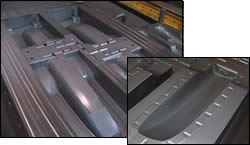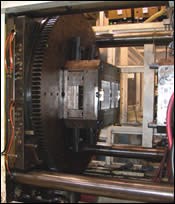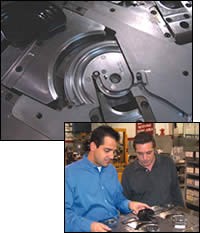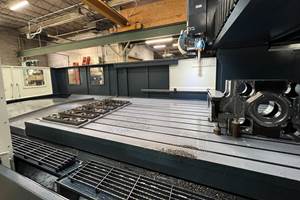Where New Machines And Methods Overshadow The Old
Eclipse Mold makes a good case for high-end machining centers as the basis for effectively machining to zero.
Share





If the benefits of cutting molds to zero stock are felt most strongly by the molder, then Eclipse Mold can testify to this fact. The company has a mold shop that produces 140 molds or so a year, but that business, which includes a substantial mold repair service, represents only 40 percent of the total. The other 60 percent of the company’s revenue comes from its three plastic injection molding facilities, all located in the suburban Detroit area. In fact, the company has 42 injection machines that range in size from 22 to 750 tons.
Eclipse Mold builds tooling for these presses at its main plant and headquarters in Clinton Township, about 20 miles northwest of downtown Detroit. The company uses machining to zero on almost all of these molds to some extent. “The net-cut molds run faster, last longer, cost less to maintain and produce better, cleaner parts,” says Steve Craprotta, VP and general manager. “We live with these results every day, so we know how valuable this approach is.”
According to Mr. Craprotta, his outside customers agree. Only about 15 percent of the molds that Eclipse produces annually are used in-house. The rest are delivered to large Tier 1 automotive suppliers whose customers include all of the familiar U.S. and Japanese automakers. “All of my customers consider me their best tool shop,” Mr. Craprotta says, but not boastfully. He makes the point because it strongly reinforces his conviction that machining to zero is an indispensable part of the shop’s competitive position in this market.
Eclipse was founded in 1976 by Fred Craprotta, Steve’s father, who is still active in managing and guiding the company. It has expanded several times, having moved to its current headquarters location in 1989. Employment at all three facilities totals around 150.
For production molding, Eclipse specializes in two-shot molds. These molds usually involve a single core or cavity that must either fit two other halves or one side that rotates 180 degrees for the second shot. “If these molds were machined conventionally, followed by a lot of hand work, spotting would take way too long for us to meet deliveries or our own production schedule,” Mr. Craprotta explains. Being able to cut shutoff surfaces to zero (or to a negative stock condition in many cases) reduces spotting time to hours. One side matches the other, and when rotated or mated with a second half, the match is nearly perfect, he says.
Most of Eclipse’s molds are complex, multi-cavity, close-tolerance molds that range in size from as large as 40 by 50 inches to as small as 8 by 8 inches, although medium-sized molds for 300- to 700-ton presses are most common. As much as 70 to 80 percent of these molds involve mechanical action such as slides, lifters, retracting cores and the like.
Machining to zero not only cuts out much of the spotting time, but it also streamlines production of mechanical components. For example, lifters drop right into pockets with little or no adjustment.
The shop largely relies on its three newest machining centers for machining to zero. These include V55 and V56 VMCs from Makino (Mason, Ohio) and a Johnford DMC-1500. All of these machines were acquired through the local distributor, Single Source Technologies (SST) in Auburn Hills, Michigan.
“The rigidity and accuracy of the Makinos are mandatory for our machining to zero capability,” Mr. Craprotta says. The larger, 30- by 50-inch table of the Johnford has enabled the shop to meet a growing demand for larger molds. According to Mr. Craprotta, it has provided zero-cutting results comparable to the smaller VMCs.
Easing Into Hard Milling
Eclipse Mold started working with SST in 1992, when the shop acquired its first Makino high speed milling machine for producing graphite electrodes. “We learned the concepts of high speed machining from these experiences,” Mr. Craprotta recalls. When this distributor began to promote hard milling for machining mold components to zero stock, Eclipse paid attention. It bought its first machining center for hard milling in 2001.
Compared with conventional milling, hard milling did seem risky and difficult at its first encounter. The prospect of breaking or burning up tools and the possibility of scrapping an expensive mold half was tough to swallow. One machine operator simply rejected the idea of doing hard milling to such close tolerances every day. “Too stressful,” he said.
“Because we were getting into this process early and ahead of other shops, we had some leeway to ease the transition,” Mr. Craprotta recounts. At first, the shop began reducing the excess stock that it normally left, moving from 0.003 inch to 0.002 and 0.001 inch as the shop gained confidence in the machine, cutters and tool paths.
Investing right away in all of the appropriate support technology for machining to zero proved to be wise, too. The shop began using balanced cutters in shrink-fit holders with HSK interfaces, for example. It upgraded its CAM programming software. Once the operators saw how well the process was working and were comfortable with new disciplines and routines, their attitude began to change.
Eventually, not only were they eager to cut to zero, but they were began to implement negative cutting on the shutoff surfaces, Mr. Craprotta says. The transition took about a year. “Shops have to expect some tension and anxiety during this time. It’s not easy.” Mr. Craprotta concludes.
He credits his programming staff with leading the way. As the staff programmed tighter and tighter surfaces, they assured the machine operators that the tool paths could be trusted. The shop uses PowerMill from Delcam (Windsor, Ontario) to generate tool paths for zero-cutting.
John Zube, one of the shop’s most experienced programmers, says that good communication between programmers and machine operators is essential. As a programmer, “I spent a lot of time on the shop floor during the transition period and still do,” Mr. Zube says. He also says that the comments and suggestions from the shop floor tell him what’s working or what might work better. “We have to learn from each other.”
Feedback from the molding side of the business is also important. Reports from these operations have helped both the programmers and the machine operators improve their results.
Rigid, Accurate And Efficient Machining
Mr. Craprotta’s advice for choosing machine tools for hard milling boils down to this: Buy the most rigid, accurate machine you can afford. Rigidity is critical because it minimizes vibration at the tip of the cutter. Of course, the rest of the tooling must be engineered for low runout and stability, too, he adds. On the Makino VMCs, features that contribute to rigid machine construction include box ways with linear roller bearings, adequate mass in the base and column, and ballscrews that are supported at both ends.
The spindles on the Makinos have a maximum speed of 20,000 rpm. Such high speeds are necessary for small cutters to attain the proper chip load when moving at high feed rates and low depths of cut. “One thing we can observe on these machines is the absence of thermal growth in the spindles. We run these machines for 10 hours straight and have no Z-depth issues,” Mr. Craprotta claims.
“A machine has to be accurate—and not just in the center of its range, but equally accurate through its whole work envelope,” Mr. Craprotta adds. Glass scales with resolutions to the millionths of an inch are also needed for the fine moves made with sub-miniature cutters. Finish cuts are performed with cutters as small as 0.010 inch, but 0.030 inch is more typical. Eclipse routinely cuts core and cavity surfaces to a ±0.0004 inch tolerance. Surface finishes are in the 16 to 24 rms range.
Efficient cutting is something that the shop has a harder time quantifying. There are few opportunities to see how quickly the Makinos can execute a tool path compared with results on another machine. Mr. Craprotta defers to what SST says about the software in the controls on the smaller machines. The Super Geometric Intelligence feature enables these machines to process servo commands at high speed with minimal look-ahead, avoiding surface violations without impeding processing speed.
The Johnford machine has the chief merit of being affordable, says Mr. Craprotta. “It represents an outstanding value in terms of price and capability,” he says. This machine has a 90-degree bridge with offset Y-axis ways to minimize deflection in the extended travel required for larger molds. Box ways in the Y and Z axes contribute to rigidity, but linear ways are used on the X axis to move heavier workpieces accurately.
However, Mr. Craprotta says the shop gets optimum results from this machine because the axis tuning performed by SST before delivery was perfect for hard milling applications. “We get the most out of this machine because it is set for high-accuracy cutting. That said, we have to be a little fussier with this machine to meet the demanding requirements for cutting to zero,” Mr. Craprotta states. Most importantly, the extended travel of this machine allows the shop to produce multi-cavity molds for larger automotive interior panels and the like. “That’s been a big growth area for us,” Mr. Craprotta says.
Finally, he emphasizes the importance of running hard milling operations in the unattended mode at least one shift a day. Typically, Eclipse Mold has a single operator on duty to monitor seven CNC machines during the first and second shifts of the day. Hard milling operations on the VMCs are set up to run unattended during the third shift, although fluctuations in workload don’t always require it.
Looking To Cast An Even Bigger Shadow
Because machining to zero has helped Eclipse become more productive, Mr. Craprotta believes that his shop has to look beyond its traditional customer base for the kind of work it can fully take on. The shop’s target is high-cavitation, tight-tolerance work for medical or aerospace customers. Mr. Craprotta believes that they would be less eager than their automotive counterparts to outsource tooling to overseas builders, and would be especially receptive to the capabilities of his and other advanced mold shops in the southeast Michigan area.
“A lot of shops in this part of the state have developed globally competitive mold manufacturing processes. We don’t want to be the best-kept secret habitually overlooked by large manufacturers who have convinced themselves that only low-wage countries offer the most cost-effective solution,” Mr. Craprotta says, speaking on behalf of Eclipse Mold and the rest of the local mold building community.
Of course, he believes that Eclipse Mold can outshine any shop for quality of work and superior service. “Machining to zero has contributed tremendously to getting us to this position,” he says. Now the shop is turning its attention to lean manufacturing techniques for further efficiencies.
Related Content
Three-Axis Bridge Mill Opens New Doors for Construction OEM
Different industries often require different machining priorities, a truism recently demonstrated by Barbco, an OEM of heavy-duty boring equipment that opened up new design possibilities by pivoting toward rigid, less complex machining centers.
Read MoreMazak VMC Provides Versatile Machining of Complex Parts
The VC-Ez 20X vertical machining center features a 25-hp 12,000-rpm CAT-40 spindle with a 30-tool-magazine automatic tool changer.
Read More5 Tips for Running a Profitable Aerospace Shop
Aerospace machining is a demanding and competitive sector of manufacturing, but this shop demonstrates five ways to find aerospace success.
Read MoreIn Moldmaking, Mantle Process Addresses Lead Time and Talent Pool
A new process delivered through what looks like a standard machining center promises to streamline machining of injection mold cores and cavities and even answer the declining availability of toolmakers.
Read MoreRead Next
Setting Up the Building Blocks for a Digital Factory
Woodward Inc. spent over a year developing an API to connect machines to its digital factory. Caron Engineering’s MiConnect has cut most of this process while also granting the shop greater access to machine information.
Read MoreBuilding Out a Foundation for Student Machinists
Autodesk and Haas have teamed up to produce an introductory course for students that covers the basics of CAD, CAM and CNC while providing them with a portfolio part.
Read More5 Rules of Thumb for Buying CNC Machine Tools
Use these tips to carefully plan your machine tool purchases and to avoid regretting your decision later.
Read More


































